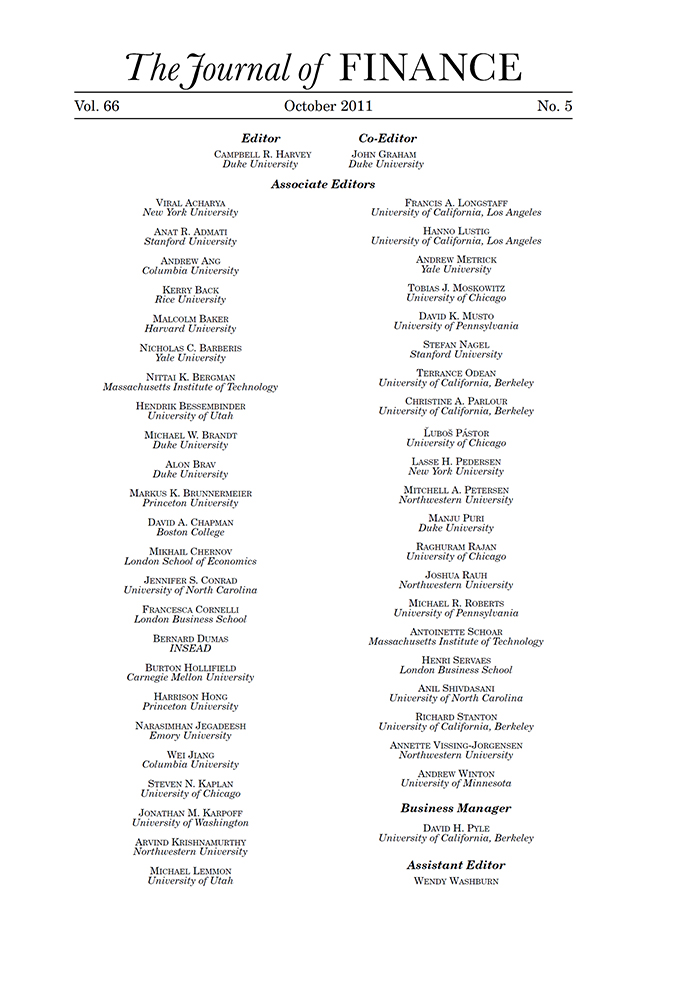Motivating Innovation
GUSTAVO MANSO
Gustavo Manso is at MIT Sloan School of Management. I thank John Roberts, Anat Admati, Darrell Duffie, and Ed Lazear for valuable discussions and suggestions. I also thank Peter DeMarzo, Bob Gibbons, Thomas Hellman, Bengt Holmstrom, Jim March, Pedro Miranda, Stew Myers, Tomasz Sadzik, Maria Salgado, Yuliy Sannikov, Antoinette Schoar, Andy Skrzypacz, Ilya Strebulaev, Alexei Tchistyi, Jeff Zwiebel, and seminar participants at the University of California at Berkeley, University of Chicago, Columbia University, Duke University, Harvard University, London Business School, London School of Economics, Massachusetts Institute of Technology, Northwestern University, New York University, Princeton University, Stanford University, University of California at Los Angeles, University of California at San Diego, University of Iowa, University of Oregon, and Wharton for helpful comments and Forrest Funnell for outstanding research assistance. Financial support from a Stanford Institute for Policy Research (SIEPR) Fellowship and the Lehman Brothers Fellowship for Research Excellence in Finance is gratefully acknowledged.
Search for more papers by this authorGUSTAVO MANSO
Gustavo Manso is at MIT Sloan School of Management. I thank John Roberts, Anat Admati, Darrell Duffie, and Ed Lazear for valuable discussions and suggestions. I also thank Peter DeMarzo, Bob Gibbons, Thomas Hellman, Bengt Holmstrom, Jim March, Pedro Miranda, Stew Myers, Tomasz Sadzik, Maria Salgado, Yuliy Sannikov, Antoinette Schoar, Andy Skrzypacz, Ilya Strebulaev, Alexei Tchistyi, Jeff Zwiebel, and seminar participants at the University of California at Berkeley, University of Chicago, Columbia University, Duke University, Harvard University, London Business School, London School of Economics, Massachusetts Institute of Technology, Northwestern University, New York University, Princeton University, Stanford University, University of California at Los Angeles, University of California at San Diego, University of Iowa, University of Oregon, and Wharton for helpful comments and Forrest Funnell for outstanding research assistance. Financial support from a Stanford Institute for Policy Research (SIEPR) Fellowship and the Lehman Brothers Fellowship for Research Excellence in Finance is gratefully acknowledged.
Search for more papers by this authorABSTRACT
Motivating innovation is important in many incentive problems. This paper shows that the optimal innovation-motivating incentive scheme exhibits substantial tolerance (or even reward) for early failure and reward for long-term success. Moreover, commitment to a long-term compensation plan, job security, and timely feedback on performance are essential to motivate innovation. In the context of managerial compensation, the optimal innovation-motivating incentive scheme can be implemented via a combination of stock options with long vesting periods, option repricing, golden parachutes, and managerial entrenchment.
REFERENCES
- Acemoglu, Daron, Simon Johnson, and James Robinson, 2002, Reversal of fortune: Geography and institutions in the making of the modern world income distribution, Quarterly Journal of Economics 117, 1231–1294.
- Acharya, Viral, Ramin Baghai-Wadji, and Krishnamurthy Subramanian, 2009, Labor laws and innovation, Working paper, London Business School.
- Acharya, Viral, Kose John, and Rangarajan Sundaram, 2000, On the optimality of resetting executive stock options Journal of Financial Economics 57, 65–101.
- Acharya, Viral, and Krishnamurthy Subramanian, 2009, Bankruptcy codes and innovation, Review of Financial Studies 22, 4949–4988.
- Aghion, Philippe, 2002, Schumpeterian growth theory and the dynamics of income inequality, Econometrica 70, 855–882.
- Aghion, Philippe, Oliver Hart, and John Moore, 1992, The economics of bankruptcy reform, Journal of Law, Economics, and Organizations 8, 523–546.
- Aghion, Philippe, and Peter Howitt, 1992, A model of growth through creative destruction, Econometrica 60, 323–352.
- Aghion, Philippe, and Jean Tirole, 1994, The management of innovation, Quarterly Journal of Economics 109, 1185–1209.
- Almazan, Andres, and Javier Suarez, 2003, Entrenchment and severance pay in optimal governance structures, Journal of Finance 58, 519–548.
- Arrow, Kenneth, 1969, Classificatory notes on the production and diffusion of knowledge, American Economic Review 59, 29–35.
- Atanassov, Julian, 2008, Quiet life or managerial myopia: Is the threat of hostile takeovers beneficial for technological innovation? Working paper, University of Oregon.
- Ayotte, Kenneth, 2007, Bankruptcy and entrepreneurship: The value of a fresh start, Journal of Law, Economics and Organization 23, 161–185.
- Azoulay, Pierre, Joshua Graff Zivin, and Gustavo Manso, 2010, Incentives and creativity: Evidence from the academic life sciences, Working paper, MIT Sloan School of Management.
-
Baird, Douglas, 1991, The initiation problem in bankruptcy, International Review of Law and Economics 11, 223–232.
10.1016/0144-8188(91)90020-E Google Scholar
- Battacharya, Sudipto, Kalyan Chatterjee, and Larry Samuelson, 1986, Sequential research and the adoption of innovations, Oxford Economic Papers 38, 219–243.
- Bebchuk, Lucian, and Jesse Fried, 2004, Pay Without Performance (Harvard University Press, Cambridge, MA).
- Bebchuk, Lucian, and Randal Picker, 1993, Bankruptcy rules, managerial entrenchment, and firm-specific human capital, Working paper, Law & Economics Working Paper No. 16, The University of Chicago Law School.
- Bekaert, Geert, Campbell Harvey, and Christian Lundblad, 2005, Does financial liberalization spur growth? Journal of Financial Economics 77, 3–55.
- Bergemann, Dirk, and Ulrich Hege, 2005, The financing of innovation: Learning and stopping, Rand Journal of Economics 36, 719–752.
- Bergemann, Dirk, and Juuso Valimaki, 2006, Bandit problems, in S. Durlauf, and L. Blume, eds. The New Palgrave Dictionary of Economics (Macmillan Press, Basingstoke, UK).
- Berkovitch, Elazar, Ronen Israel, and Jaime Zender, 1997, Optimal bankruptcy law and firm-specific investments, European Economic Review 41, 487–497.
- Berle, Adolph, and Gardiner Means, 1932, The Modern Corporation and Private Property (Macmillan, New York, NY).
-
Berry, Donald, and Bert Fristedt, 1985, Bandit Problems: Sequential Allocation of Experiments (Chapman and Hall, New York, NY).
10.1007/978-94-015-3711-7 Google Scholar
- Burkart, Mike, Denis Gromb, and Fausto Panunzi, 1997, Large shareholders, monitoring, and the value of the firm, Quarterly Journal of Economics 112, 693–728.
- Bushee, Brian, 1998, The influence of institutional investors on myopic R&D investment behavior, Accounting Review 73, 305–333.
- Dechow, Patricia, and Richard Sloan, 1991, Executive incentives and the horizon problem, Journal of Accounting and Economics 14, 51–89.
- Diaz, Miguel, Luis Rayo, and Haresh Sapra, 2009, Market pressure, control rights, and innovation, Working paper, University of Chicago Graduate School of Business.
- Ederer, Florian, 2010a, Feedback and motivation in dynamic tournaments, Journal of Economics & Management Strategy 19, 733–769.
- Ederer, Florian, 2010b, Launching a thousand ships: Incentives for parallel innovation, Working paper, UCLA.
- Ederer, Florian, and Gustavo Manso, 2010, Is pay-for-performance detrimental to innovation? Working paper, MIT.
- Farson, Richard, and Ralph Keyes, 2002, Whoever Makes the Most Mistakes Wins: The Paradox of Innovation (The Free Press, New York, NY).
-
Feltham, Gerald, and Martin Wu, 2001, Incentive efficiency of stock versus options, Review of Accounting Studies 6, 7–28.
10.1023/A:1011377902967 Google Scholar
- Francis, Bill, Iftekhar Hasan, and Zenu Sharma, 2009, Do incentives create innovation? Evidence from CEO compensation contracts, Working paper, Rensselaer Polytechnic Institute.
- Fuchs, William, 2007, Contracting with repeated moral hazard and private evaluations, American Economic Review 73, 1432–1448.
- Fudenberg, Drew, Bengt Holmstrom, and Paul Milgrom, 1990, Short-term contracts and long-term agency relationships, Journal of Economic Theory 51, 1–31.
- Gompers, Paul, and Josh Lerner, 2004, The Venture Capital Cycle (MIT Press, Cambridge, MA).
- Graham, John, Campbell Harvey, and Shiva Rajgopal, 2005, The economic implications of corporate financial reporting, Journal of Accounting and Economics 40, 3–73.
- Harris, Milton, and Artur Raviv, 1978, Some results on incentive contracts with applications to education, insurance, and law enforcement, American Economic Review 68, 20–30.
- Hellmann, Thomas, 2007, When do employees become entrepreneurs? Management Science 53, 919–933.
- Hellmann, Thomas, and Veikko Thiele, 2008, Incentives and innovation inside firms: A multi-tasking approach, Working paper, University of British Columbia.
- Hermalin, Benjamin, and Michael Katz, 1991, Moral hazard and verifiability: The effects of renegotiation in agency, Econometrica 59, 1735–1753.
- Holmstrom, Bengt, 1979, Moral hazard and observability, Bell Journal of Economics 10, 74–91.
- Holmstrom, Bengt, 1989, Agency costs and innovation, Journal of Economic Behavior and Organization 12, 305–327.
- Holmstrom, Bengt, and Paul Milgrom, 1991, Multi-task principal-agent analysis, Journal of Law, Economics, and Organizations 7, 24–52.
- Inderst, Roman, and Holger Mueller, 2010, CEO replacement under private information, Review of Financial Studies 23, 2935–2969.
-
Jensen, Michael, 1991, Corporate control and the politics of finance, Journal of Applied Corporate Finance 4, 13–33.
10.1111/j.1745-6622.1991.tb00603.x Google Scholar
- Jensen, Richard, 1982, Adoption and diffusion of an innovation of uncertain probability, Journal of Economic Theory 27, 182–193.
- Jovanovic, Boyan, and Yaw Nyarko, 1996, Learning by doing and the choice of technology, Econometrica 64, 1299–1310.
- Jovanovic, Boyan, and Rafael Rob, 1990, Long waves and short waves: Growth through intensive and extensive search, Econometrica 58, 1391–1409.
- King, Robert, and Ross Levine, 1993, Finance and growth: Schumpeter might be right, Quarterly Journal of Economics 108, 717–737.
- La Porta, Rafael, Florencio Lopez-de Silanes, Andrei Shleifer, and Robert Vishny, 1997, Legal determinants of external finance, Journal of Finance 52, 1131–1150.
- Lambert, Richard, 1986, Executive effort and selection of risky projects, The Rand Journal of Economics 17, 77–88.
- Landier, Augustin, 2002, Entrepreneurship and the stigma of failure, Working paper, University of Chicago Graduate School of Business.
- Lazear, Edward, 1986, Salaries and piece rates, The Journal of Business 59, 405–431.
- Lerner, Josh, and Julie Wulf, 2007, Innnovation and incentives: Evidence from corporate R&D, Review of Economics and Statistics 89, 634–644.
- Lizzeri, Alessandro, Margaret Meyer, and Nicola Persico, 2002, The incentive effects of interim performance evaluations, Working paper, CARESS.
- March, James, 1991, Exploration and exploitation in organizational learning, Organization Science 2, 71–87.
- Moscarini, Giuseppe, and Lones Smith, 2001, The optimal level of experimentation, Econometrica 69, 1629–1644.
- Myers, Stewart, 2000, Outside equity, Journal of Finance 55, 1005–1037.
-
Narayanan, M. P., 1985, Managerial incentives for short-term results, Journal of Finance 15, 1469–1484.
10.1111/j.1540-6261.1985.tb02395.x Google Scholar
- Nelson, Richard, 1959, The simple economics of basic scientific research, Journal of Political Economy 67, 297–306.
- Povel, Paul, 1999, Optimal “soft” or “tough” bankruptcy procedures, Journal of Law, Economics and Organization 15, 659–684.
- Prendergast, Canice, 2002, The tenuous trade off between risk and incentives, Journal of Political Economy 110, 1071–1102.
- Rajan, Raghuram, and Luigi Zingales, 1998, Financial dependence and growth, American Economic Review 88, 559–586.
- Ray, Korok, 2007, Performance evaluation and efficient sorting, Journal of Accounting Research 45, 839–882.
- Roberts, Kevin, and Martin Weitzman, 1981, Funding criteria for research, development, and exploration projects, Econometrica 49, 1261–1288.
- Romer, Paul, 1986, Increasing returns and long-run growth, Journal of Political Economy 94, 1002–1037.
- Sapra, Haresh, Ajay Subramanian, and Krishnamurthy Subramanian, 2009, Corporate governance and innovation: Theory and evidence, Working paper, University of Chicago Graduate School of Business.
- Schumpeter, Joseph, 1934, The Theory of Economic Development (Harvard University Press, Cambridge, MA).
- Seru, Amit, 2010, Do conglomerates stifle innovation? Firm boundaries matter: Evidence from congloneratey and R&D activity, Journal of Financial Economics, forthcoming.
- Shleifer, Andrei, and Robert Vishny, 1990, Equilibrium short horizons of investors and firms, American Economic Review 80, 148–153.
- Stein, Jeremy, 1988, Takeover threats and managerial myopia, Journal of Political Economy 96, 61–80.
- Stein, Jeremy, 1989, Efficient capital markets, inefficient firms: A model of corporate behavior, Quarterly Journal of Economics 104, 655–669.
- Stiglitz, Joseph, and Andrew Weiss, 1983, Incentive effects of termination: Applications to the credit and labor markets, American Economic Review 73, 912–927.
- Sutton, Robert, 2002, Weird Ideas that Work: 11 1/2 Practices for Promoting, Managing, and Sustaining Innovation (The Free Press, New York, NY).
- Thomke, Stefan, 2002, Bank of America, Harvard Business School case studies 9–603–022 and 9–603–023 (Harvard Business School Publishing, Boston, MA).
- Tian, Xuan, and Tracy Wang, 2010, Tolerance for failure and corporate innovation, Working paper, Indiana University.
- Weitzman, Martin, 1979, Optimal search for the best alternative, Econometrica 47, 641–654.
- Zwiebel, Jeffrey, 1995, Corporate conservatism and relative compensation, Journal of Political Economy 103, 1–25.




